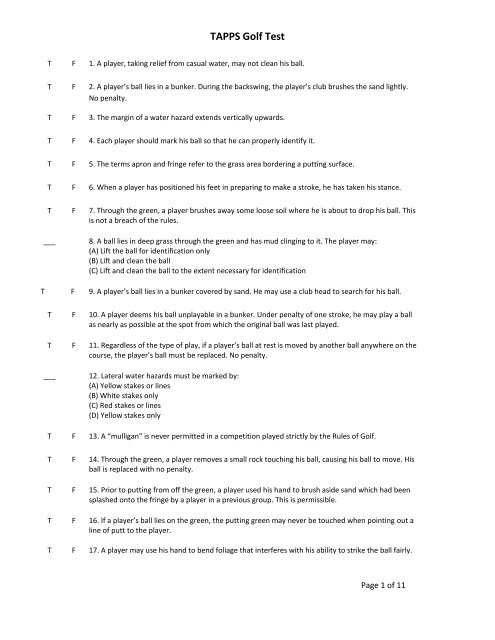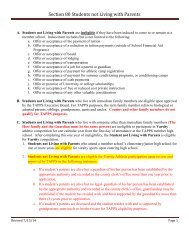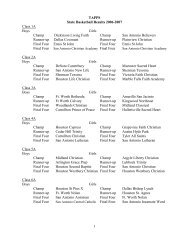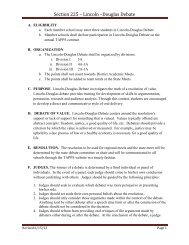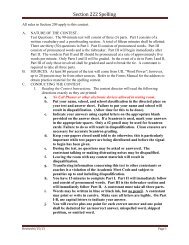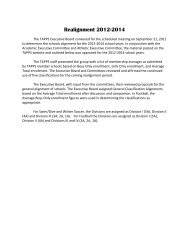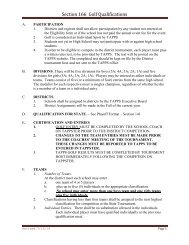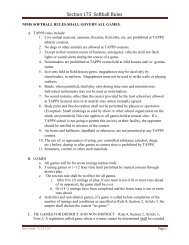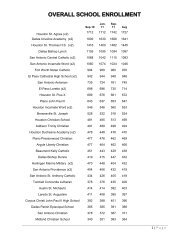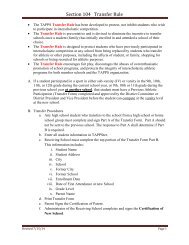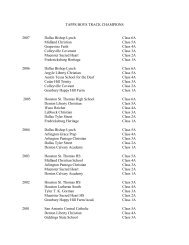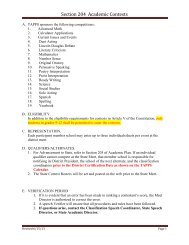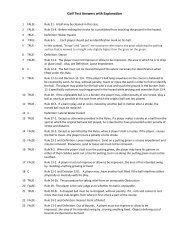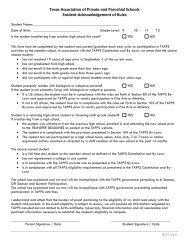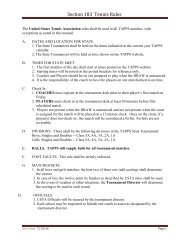Create successful ePaper yourself
Turn your PDF publications into a flip-book with our unique Google optimized e-Paper software.
<strong>TAPPS</strong> <strong>Golf</strong> <strong>Test</strong><br />
T F 1. A player, taking relief from casual water, may not clean his ball.<br />
T F 2. A player’s ball lies in a bunker. During the backswing, the player’s club brushes the sand lightly.<br />
No penalty.<br />
T F 3. The margin of a water hazard extends vertically upwards.<br />
T F 4. Each player should mark his ball so that he can properly identify it.<br />
T F 5. The terms apron and fringe refer to the grass area bordering a putting surface.<br />
T F 6. When a player has positioned his feet in preparing to make a stroke, he has taken his stance.<br />
T F 7. Through the green, a player brushes away some loose soil where he is about to drop his ball. This<br />
is not a breach of the rules.<br />
___<br />
8. A ball lies in deep grass through the green and has mud clinging to it. The player may:<br />
(A) Lift the ball for identification only<br />
(B) Lift and clean the ball<br />
(C) Lift and clean the ball to the extent necessary for identification<br />
T F 9. A player’s ball lies in a bunker covered by sand. He may use a club head to search for his ball.<br />
T F 10. A player deems his ball unplayable in a bunker. Under penalty of one stroke, he may play a ball<br />
as nearly as possible at the spot from which the original ball was last played.<br />
T F 11. Regardless of the type of play, if a player’s ball at rest is moved by another ball anywhere on the<br />
course, the player’s ball must be replaced. No penalty.<br />
___<br />
12. Lateral water hazards must be marked by:<br />
(A) Yellow stakes or lines<br />
(B) White stakes only<br />
(C) Red stakes or lines<br />
(D) Yellow stakes only<br />
T F 13. A “mulligan” is never permitted in a competition played strictly by the Rules of <strong>Golf</strong>.<br />
T F 14. Through the green, a player removes a small rock touching his ball, causing his ball to move. His<br />
ball is replaced with no penalty.<br />
T F 15. Prior to putting from off the green, a player used his hand to brush aside sand which had been<br />
splashed onto the fringe by a player in a previous group. This is permissible.<br />
T F 16. If a player’s ball lies on the green, the putting green may never be touched when pointing out a<br />
line of putt to the player.<br />
T F 17. A player may use his hand to bend foliage that interferes with his ability to strike the ball fairly.<br />
Page 1 of 11
<strong>TAPPS</strong> <strong>Golf</strong> <strong>Test</strong><br />
___<br />
18. A player may, under Rule 22, have another ball lifted if it:<br />
(A) Interferes physically with his play<br />
(B) Interferes mentally with his play<br />
(C) Either A or B<br />
T F 19. A cart path interferes with a player’s stance. He may determine the nearest point of relief, no<br />
nearer the hole and drop within one club-length of that point.<br />
T F 20. A player declares his ball unplayable outside a water hazard. His opponent disputes this claim. A<br />
referee must decide when the ball is unplayable.<br />
T F 21. A dropped ball rolls and comes to rest more than two club-lengths from where it struck the<br />
ground but is no nearer the hole. The ball must be re-dropped.<br />
T F 22. A player’s ball lies on a paved cart path. He may take relief on either side of the path.<br />
T F 23. A player removes an out of bounds stake that interferes with his swing. This is permitted.<br />
T F 24. From the teeing ground, a player decides to hit a provisional ball. The player should wait until his<br />
fellow-competitors have played their first stroke.<br />
T F 25. Only the club head may be used to strike the ball.<br />
T F 26. In stroke play, a competitor’s ball rebounds from a cart path and strikes a fellow-competitor. No<br />
penalty.<br />
T F 27. When a ball is out of bounds or lost, it is no longer in play.<br />
T F 28. Thinking his ball is out of bounds, a player plays a provisional ball from the teeing ground. He<br />
searches for five minutes but does not find the original ball. He plays the provisional ball to the hole.<br />
The original ball is then found and is not out of bounds. The original ball is in play.<br />
T F 29. The line defining ground under repair is not considered ground under repair.<br />
T F 30. A ball is embedded within a water hazard. A player may obtain relief without penalty under the<br />
embedded ball Rule.<br />
___<br />
31. A ball is holed when:<br />
(A) Any part of it is below the lip of the hole<br />
(B) All of it is below the lip of the hole<br />
(C) Most of it is below the lip of the hole<br />
T F 32. Prior to taking his stance, a player uses his club to break a small seedling, which was immediately<br />
behind his ball. He has improved the lie of his ball.<br />
___<br />
33. A player’s ball is covered with mud outside a hazard. He wants to lift and identify the ball. The<br />
first thing he must do is:<br />
(A) Mark the spot<br />
(B) Lift his ball<br />
Page 2 of 11
<strong>TAPPS</strong> <strong>Golf</strong> <strong>Test</strong><br />
(C) Advise his opponent<br />
T F 34. A player leans on his putter during a round and the shaft breaks. This accidental damage could<br />
be considered as occurring during the “normal course of play”.<br />
T F 35. The line for out of bounds extends vertically upwards and downwards.<br />
T F 36. A player’s ball lies on a movable obstruction. He may lift and drop his ball, but he may not clean<br />
his ball.<br />
___<br />
37. A player plays his second shot to the green and his ball strikes the flagstick, which was left lying<br />
on the green by the preceding group. What is the ruling?<br />
(A) Two penalty strokes and the ball is played as it lies<br />
(B) The player replays the stroke without penalty<br />
(C) No penalty and the ball is played as it lies<br />
T F 38. After a stroke from the teeing ground, a player’s ball lands in a bunker and is unplayable. Under<br />
penalty of one stroke he may play his next stroke from the teeing ground.<br />
___<br />
39. A provisional ball may be played whenever a player thinks his original ball may be:<br />
(A) Lost in a water hazard or out of bounds<br />
(B) Out of bounds<br />
(C) Unplayable or out of bounds<br />
T F 40. A flat sprinkler head on the apron of the green intervenes on a player’s line of play. Relief is<br />
permitted.<br />
___<br />
41. A player’s ball lies in a bunker. He leans on his club in the bunker while waiting his turn to play.<br />
What is the ruling?<br />
(A) No penalty because he has not taken his stance<br />
(B) Two-stroke penalty<br />
(C) No penalty because he has not addressed his ball<br />
T F 42. Information on the Rules is not advice.<br />
___<br />
43. A player cleans his ball when determining whether it is unfit for play.<br />
(A) Two-stroke penalty<br />
(B) One-stroke penalty<br />
(C) No penalty<br />
T F 44. Part of a player’s ball lies within ground under repair. The whole ball is not within such ground.<br />
Relief is permitted.<br />
___<br />
45. A player’s ball is in an excellent lie within a water hazard, but his backswing is restricted by an<br />
immovable obstruction. He may do which of the following?<br />
(A) Declare the ball unplayable<br />
(B) Take relief from the obstruction without penalty<br />
(C) Neither of the above<br />
Page 3 of 11
<strong>TAPPS</strong> <strong>Golf</strong> <strong>Test</strong><br />
___<br />
46. The whole ball rests on a line on the ground defining out of bounds. A player may:<br />
(A) Play the ball<br />
(B) Not play the ball because it is out of bounds<br />
(C) Stand out of bounds and play the ball<br />
(D) Play the ball if his stance is within bounds<br />
T F 47. A player’s ball lies in casual water in long grass through the green. He is entitled to drop from<br />
casual water. The dropped ball rolls onto a closely mown area through the green, no nearer the<br />
hole. He must re-drop in the long grass.<br />
T F 48. Strokes played with a wrong ball do not count in a competitor’s score.<br />
T F 49. A player’s ball lands on the apron of a wrong green. He must drop within one club-length of the<br />
apron, no nearer the hole.<br />
T F 50. A player’s ball rests against a movable bench. He may remove the bench or drop within one<br />
club-length of the spot.<br />
___<br />
51. A player wraps his handkerchief around the grip of his club to make a stroke.<br />
(A) The handkerchief must be removed prior to the stroke<br />
(B) This is permissible<br />
T F 52. In stroke play, if a competitor is doubtful of his rights, he may play a second ball in addition to<br />
his original ball. Prior to making a stroke with either, he must announce his intention to play two<br />
balls and he must choose which one he will score with if the Rules permit.<br />
T F 53. A player’s ball lies close to a paved cart path. He is prohibited from standing on the path to make<br />
a stroke at his ball and he must take relief.<br />
___<br />
___<br />
___<br />
54. A player’s ball lies in a bunker. A fallen tree limb is touching his ball.<br />
(A) The player may remove the limb<br />
(B) The player may not remove limb, but he may drop another ball<br />
(C) None of the above<br />
55. A player’s ball lies in a water hazard. A hole made by a burrowing animal interferes with his<br />
stance. What is the ruling?<br />
(A) Play the ball as it lies<br />
(B) Proceed under the water hazard Rule<br />
(C) Either of the above<br />
56. Sand may be considered a loose impediment and removed from the line of play when:<br />
(A) On the green or apron of the green<br />
(B) On the green only<br />
(C) On the green or on the apron of the green if the player chooses to putt<br />
T F 57. Wind is an outside agency but water is not.<br />
T F 58. A bird’s nest in a hazard interferes with a player’s stance. He may drop a ball, without penalty,<br />
within one club-length of and not nearer the hole than the nearest spot that would allow him to<br />
Page 4 of 11
<strong>TAPPS</strong> <strong>Golf</strong> <strong>Test</strong><br />
make his stroke without damaging the nest. If possible the ball must be dropped in the same hazard<br />
and, if not possible, in a similar nearby hazard, no closer to the hole.<br />
T F 59. A player may not declare his ball unplayable in a bunker.<br />
___<br />
___<br />
60. A player’s ball lies within a water hazard. He may:<br />
(A) Play the ball as it lies<br />
(B) Drop a ball behind the water hazard, keeping the point at which the original ball last crossed the<br />
margin of the water hazard directly between the hole and the spot on which the ball is dropped,<br />
with no limit to how far behind the water hazard the ball may be dropped<br />
(C) Play a ball as nearly as possible at the spot from which the original ball was last played<br />
(D) Do any of the above<br />
61. A player with more than 14 clubs may incur a maximum penalty of:<br />
(A) One stroke for each hole played<br />
(B) Two strokes<br />
(C) Two strokes for each hole played<br />
(D) Four strokes<br />
T F 62. A player’s ball lies on a movable obstruction within a hazard. He gets no relief without a penalty.<br />
T F 63. A player asks his opponent if a bunker exists beyond a dogleg of the hole being played. This is<br />
permitted because it is public information.<br />
T F 64. An empty potato chip bag lying in a bunker is a loose impediment and may not be moved.<br />
T F 65. After a putting stroke, a player’s ball stops an inch from the hole. The player then taps the ball<br />
with the grip end of the putter and holes out. This is prohibited.<br />
T F 66. The outside of a stake determines the out of bounds line.<br />
T F 67. A player’s ball lies through the green but he must stand with both feet out of bounds in order to<br />
make a stroke at his ball. This is prohibited.<br />
T F 68. A player’s ball is touching a water hazard stake and the ball is in the hazard. The stake may be<br />
removed.<br />
T F 69. A ball is out of bounds when any part of it is out of bounds.<br />
___<br />
70. A player has not begun a search for his ball, but his opponent has spent 3 minutes searching for<br />
the player’s ball. The player has ______ minutes left to search for his ball.<br />
(A) 2 minutes<br />
(B) 5 minutes<br />
(C) 7 minutes<br />
T F 71. Equipment includes anything used, worn, or carried by or for the player.<br />
T F 72. There is no penalty when a player plays a wrong ball from any hazard.<br />
Page 5 of 11
<strong>TAPPS</strong> <strong>Golf</strong> <strong>Test</strong><br />
T F 73. A player’s ball lies within an area marked ground under repair. He may play the ball as it lies.<br />
T F 74. A player declares his ball to be lost without searching for it. This is a breach of the Rules.<br />
T F 75. A drainage ditch on the course is marked as a water hazard but does not contain any water. A<br />
player finds his ball in the ditch in a bad lie. He declares his ball unplayable. This is permitted.<br />
T F 76. A player’s ball lands on a wrong putting green. He gets no relief without penalty.<br />
T F 77. A competitor in stroke play is disqualified if he fails to hole out before playing from the next tee.<br />
T F 78. The teeing ground is two club-lengths in width.<br />
T F 79. Loose impediments on the putting green may be brushed aside with a player’s hand or club only.<br />
T F 80. The margin of a water hazard extends vertically upwards, but the margin of a bunker does not.<br />
T F 81. A player’s ball lies near a flat sprinkler head. The sprinkler head interferes with his stance. The<br />
player may take relief without penalty.<br />
T F 82. A player’s ball lies through the green where a tall weed interferes with his backswing. Prior to<br />
making a stroke, the player bends the weed out of his way. This is permissible.<br />
T F 83. A player’s ball lies on a replaced divot. To preserve the course, he presses down on the area with<br />
his foot. This is prohibited.<br />
T F 84. A rain shelter intervenes on a player’s line of play to the hole. It does not interfere with his<br />
stance or the area of his intended swing. He must play the ball as it lies.<br />
___<br />
85. Relief from a movable obstruction is:<br />
(A) One club-length<br />
(B) Two club-lengths<br />
(C) None of the above<br />
T F 86. The flagstick is removed and placed on the putting green. A competitor putts and the ball rolls<br />
beyond the hole and strikes the flagstick. The ball must be played as it lies and two penalty strokes<br />
added to the competitor’s score for that hole.<br />
T F 87. Inadvertently, the scores for two holes were transposed on a competitor’s scorecard. The total is<br />
correct, but one of the scores on a hole was lower than actually taken. He is disqualified.<br />
T F 88. On the putting green, a player is deemed to have addressed the ball when he has taken his<br />
stance.<br />
T F 89. A stroke is the forward movement of the club with the intention of striking at and moving the<br />
ball.<br />
Page 6 of 11
<strong>TAPPS</strong> <strong>Golf</strong> <strong>Test</strong><br />
___<br />
90. If a player’s club strikes the ball more than once in the course of a stroke, what is the ruling?<br />
(A) The stroke counts<br />
(B) The stroke counts and add one penalty stroke<br />
(C) The stroke counts and add two penalty strokes<br />
T F 91. A player’s ball overhangs the edge of the hole. The player walks up to the hole and waits 8<br />
seconds, after which the ball falls into the hole. The ball must be replaced.<br />
___<br />
92. After determining the nearest point of relief from ground under repair, the player’s relief is<br />
limited to ______ from the point.<br />
(A) Two club-lengths<br />
(B) One club-length<br />
(C) Not more than two club-lengths<br />
Y N 93. Should I stand directly behind a player when he is addressing his ball or making a stroke?<br />
Y N 94. If my opponent and I decide not to count whiffs, will I be disqualified?<br />
Y N 95. In stroke play, do I need to finish putting if my fellow-competitor gives me the putt?<br />
Y N 96. May I ask my opponent for information on the Rules or Local Rules?<br />
Y N 97. If my ball falls off or is knocked off the tee when I am addressing it, may I re-tee my ball without<br />
penalty?<br />
Y N 98. May I move my ball without penalty if my ball is behind a clump of grass?<br />
Y N 99. Through the green, may I step on the ground behind my ball or press it down with my club<br />
head?<br />
Y N 100. Through the green, may I move a loose impediment such as a twig, leaf, or stone away from my<br />
ball without penalty if my ball doesn’t move?<br />
Y N 101. Through the green, if I play the wrong ball, may I replace it and then play my own ball without<br />
penalty?<br />
Y N 102. Must I re-drop my ball if it rolls more than two club-lengths from the point where it first struck<br />
the ground?<br />
Y N 103. Through the green, should I count one penalty stroke and replace my ball if it rolls into a new<br />
position after I have addressed it and before I have taken my stroke?<br />
Y N 104. If my ball is lost, must I play my next stroke as nearly as possible from the spot where I last<br />
played it and add one penalty stroke?<br />
Y N 105. If my ball is in an unplayable lie next to a tree, is my only choice to drop within two clublengths<br />
of the tree and add one penalty stroke?<br />
Page 7 of 11
<strong>TAPPS</strong> <strong>Golf</strong> <strong>Test</strong><br />
Y N 106. If my ball goes out of bounds, do I play my next stroke from where it went out and add one<br />
penalty stroke?<br />
Y N 107. If my ball has landed against a drinking fountain, may I play it as it lies or obtain relief at the<br />
nearest point (not nearer the hole) for my stance and swing and then drop the ball within one clublength<br />
with no penalty?<br />
Y N 108. Do I always have to play my ball out of a puddle of rain water?<br />
Y N 109. May I place my club head down on the ground before making a stroke in a hazard?<br />
Y N 110. If my ball lies in or is lost in a water hazard, is my only choice to drop a ball behind the hazard,<br />
keeping that point between myself and the hole?<br />
Y N 111. I am playing my ball from off the green and my ball hits an unattended flagstick. Do I incur one<br />
penalty stroke?<br />
Y N 112. In stroke play, will I be penalized if my ball hits my fellow-competitor’s ball at rest on the<br />
putting green after I make a stroke from the putting green?<br />
Y N 113. Will I be penalized if I stop playing and come in when I see lightning?<br />
Y N 114. Are tee-markers deemed to be fixed when playing the first stroke of the hole being played?<br />
___<br />
___<br />
___<br />
___<br />
115. Which of the following would be considered advice? Asking<br />
(A) Direction and yardage of the hole<br />
(B) Hole location on a blind green<br />
(C) Which club a fellow-competitor just used to make a stroke<br />
116. Your ball lands on a paved cart path. You may<br />
(A) Drop within one club-length after obtaining relief for stance and swing not nearer the hole.<br />
(B) Drop within two club-lengths after obtaining relief for stance and swing not nearer the hole.<br />
(C) Play it as it lies<br />
(D) A and C above<br />
(E) B and C above<br />
117. You incur a one stroke penalty if your ball in motion after a stroke hits<br />
(A) Your opponent or his bag<br />
(B) You or your golf bag<br />
(C) A dog running across the course<br />
(D) The ball washer behind the green<br />
118. A ball is lost after you have searched for it<br />
(A) 10 minutes<br />
(B) 7 minutes<br />
(C) 5 minutes<br />
(D) 3 minutes<br />
Page 8 of 11
<strong>TAPPS</strong> <strong>Golf</strong> <strong>Test</strong><br />
___<br />
___<br />
___<br />
___<br />
___<br />
___<br />
119. A ball is out of bounds when<br />
(A) Most of it is out of bounds<br />
(B) All of it lies out of bounds<br />
(C) You have to stand out of bounds to play the stroke<br />
120. A player addresses his ball and starts his backswing. During his backswing his ball moves. The<br />
player continues his swing and hits his ball. What is the ruling?<br />
(A) No penalty - play ball as it lies<br />
(B) One-stroke penalty - play ball as it lies<br />
(C) Two-stroke penalty - play ball as it lies<br />
(D) One-stroke penalty - replace ball<br />
(E) Two-stroke penalty - replace ball<br />
121. On the teeing ground, how far behind the tee markers may a player tee up the ball?<br />
(A) Up to one club-length<br />
(B) Six feet<br />
(C) Up to two club-lengths<br />
122. When his ball lies on the putting green, a player may:<br />
(A) Repair ball marks<br />
(B) Repair spike marks<br />
(C) Remove loose impediments<br />
(D) Both A & B<br />
(E) Both A & C<br />
123. Arrange the following in order from the lowest score to the highest score: Par, Double Eagle,<br />
Birdie, Double bogey, Bogey, Eagle.<br />
124. Water hazards (other than lateral water hazards) must be marked by:<br />
(A) Yellow stakes or lines<br />
(B) White stakes only<br />
(C) Red stakes or lines<br />
(D) Yellow stakes only<br />
Y N 125. In stroke play, if a player is uncertain as to his rights or procedure, may he complete the hole<br />
with two balls and then ask the Committee after the round which ball was played in accordance<br />
with the Rules of <strong>Golf</strong>?<br />
___<br />
126. What is the maximum number of clubs a player may have when he begins a round of golf?<br />
Y N 127. Should a player put an identification mark on his golf ball?<br />
___<br />
128. A player will be disqualified from a stroke play competition if he:<br />
(A) Returns his scorecard which he has signed and but his marker has not.<br />
(B) Completes the play of two more holes after play has been suspended by the Committee<br />
(C) Practices putting on the fairway while waiting to hit his approach shot to the green.<br />
(D) Does any of the above<br />
(E) Does either (A) or (B)<br />
Page 9 of 11
<strong>TAPPS</strong> <strong>Golf</strong> <strong>Test</strong><br />
T F 129. On the day of a tournament, if the practice green is too full to practice on then a player may<br />
practice on one of the greens on the course.<br />
T F 130. After a player has holed out, he may practice chipping or putting on or near the green provided<br />
it does not delay play.<br />
T F 131. A player may change balls on the putting green, so that he may putt with a better ball.<br />
T F 132. A player is not necessarily entitled to see his ball when making a stroke.<br />
___<br />
133. In stroke play, a player plays from the white tee markers but should have played from the blue<br />
tee markers. He should<br />
(A) Play the ball as it lies and add 2 penalty strokes<br />
(B) Play the ball from within the correct teeing ground and add 2 penalty strokes<br />
(C) Play the ball from the correct teeing ground and add 1 penalty stroke<br />
Y N 134. A player whiffed his tee shot and then nervously nudged the ball off the tee before trying<br />
again. Is a penalty stroke added?<br />
___<br />
135. If a player grounds his club in a hazard there is<br />
(A) A two-stroke penalty<br />
(B) A one-stroke penalty<br />
(C) No penalty<br />
T F 136. A player must always find and indentify his ball in order to deem it unplayable.<br />
Y N 137. My fellow-competitor and I accidently exchange balls on a hole. I hit the wrong ball 3 times<br />
before we go back to correct the mistake. Do I include those 3 strokes in my score?<br />
___<br />
138. My fellow-competitor and I accidently exchange balls on a hole and finish the hole. We<br />
discover the mistake on the next tee. Before we tee off we must<br />
(A) Agree that the scores stand and each return the other’s ball<br />
(B) Add a two-stroke penalty to each of our scores<br />
(C) Go back to where the exchange was made, add a two-stroke penalty to each of our scores on<br />
that hole and continue play with the correct ball.<br />
T F 139. The penalty for fixing a spike mark on my line of putt is one stroke.<br />
___<br />
140. If a ball is overhanging the lip of the hole, a player is allowed enough time to reach the hole<br />
without unreasonable delay and an additional<br />
(A) 5 seconds<br />
(B) 10 seconds<br />
(C) 15 seconds<br />
T F 141. A player is on the putting green and holes a putt without taking the flagstick out of the hole.<br />
The player incurs a two-stroke penalty.<br />
T F 142. A player hits his ball and his ball hits his bag. He plays the ball where it lies and adds a onestroke<br />
penalty.<br />
Page 10 of 11
<strong>TAPPS</strong> <strong>Golf</strong> <strong>Test</strong><br />
___<br />
___<br />
143. In match play, a player hits his ball and his ball hits his opponent’s bag. He<br />
(A) May replay the stroke with no penalty<br />
(B) Adds a two-stroke penalty and plays his ball as it lies<br />
(C) May play his ball as it lies<br />
(D) A and C<br />
144. If you drop a ball in a correct place and in a correct manner and it rolls out of bounds, and you<br />
re-drop and the same thing happens, how do you proceed?<br />
(A) Place the ball at the spot where it hit the ground when it was re-dropped<br />
(B) Keep dropping the ball until it doesn’t roll out of bounds<br />
(C) Neither of the above<br />
T F 145. Loose impediments are natural objects provided they are not fixed or growing, are not solidly<br />
embedded and do not adhere to the ball.<br />
T F 146. If electing to take relief from an immovable obstruction, a player must drop the ball within two<br />
club-lengths of the nearest point of relief that is no nearer the hole.<br />
Y N 147. Is a player entitled to relief from an immovable obstruction in a water hazard?<br />
Y N 148. Is a player entitled to relief if his ball that lies through the green is on a runway made by a<br />
burrowing animal?<br />
Y N 149. If a player’s ball is embedded in its own pitch mark in any closely mown area through the<br />
green, is the player entitled to relief without penalty?<br />
T F 150. If a player’s ball is on the wrong putting green, he must obtain relief by proceeding to the point<br />
that is not nearer the hole and is not in a hazard or on a putting green and drop within two clublengths<br />
without penalty.<br />
Page 11 of 11


